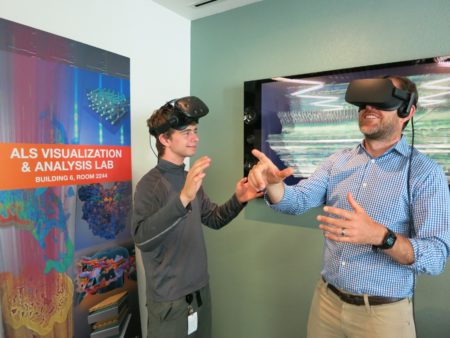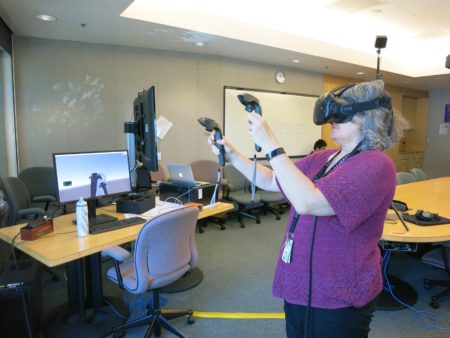by Ashley White
For ALS Summer Intern Sam Schickler, the most exciting part about Berkeley Lab’s Advanced Light Source (ALS) isn’t its famous dome, the particle accelerator it houses, or the x-ray experiments themselves—it’s the data. It’s why the rising 11th grader jumped at the chance to spend the summer at the ALS developing virtual reality (VR) experiences of ALS data and the ALS facility. What he didn’t expect was how much impact his work would have across the ALS.

Before his internship began, Schickler was already developing VR software to help visualize scientific data. Inspired by visits to the ALS as a middle schooler, in which he and classmates took 3D x-ray images of a range of different materials, Schickler had been working since to develop a straightforward way to explore that 3D data in VR.
As his mentor, ALS Beamline Scientist Dula Parkinson, explained, “Getting a new dataset into the VR environment isn’t something that’s set up beforehand. Plus, most people don’t know how to use the 3D software to navigate the dataset.” The goal was to make it easy for anyone, regardless of expertise, to be able to explore their data. Schickler’s app, which is available for free download and has an accompanying tutorial, allows a 3D data file to be viewed in an HTC Vive or Oculus Rift VR headset and manipulated—users can move the object, scale it up and down, and walk around and through it to explore it.
“There really isn’t much designed for this yet,” said Schickler, who noted that the focus of VR software has been on gaming, rather than scientific, applications.
However, Schickler quickly proved he could do much more with his summer. “We were able to explore data sets in VR in the first day,” said Parkinson. Schickler’s new goal became to create a much more immersive experience. Instead of viewing the dataset on its own, what if someone could experience walking into the ALS, over to the beamline, and then peering into a sample’s microscopic secrets? For that, Schickler would need a 3D electronic model of the entire ALS.
He started talking to staff around the ALS. An introduction from beamline staff to Engineering Division staff ended up leading to the Lab’s Accelerator Survey and Alignment Group. Among Survey and Alignment’s responsibilities is keeping precise, quantifiable records of where all the accelerator and key beamline components at the ALS are located. To do this, they use a highly sophisticated laser scanning system capable of 1 millimeter accuracy. But Schickler needed something more nimble—photorealistic models that could be created, processed, and manipulated quickly and easily. Online research led him to Matterport’s infrared scanning system, which takes photographs with a 3D camera and combines them into a single, high-resolution VR model. But he would still need to convince someone to buy the system.
Schickler arranged a meeting with David Humphries, the head of the Survey and Alignment Group, and outlined the use case. Although Matterport’s infrared scanner is only a tenth as accurate as the laser scanning system, it can take data with the touch of a button. The large photographic and point-cloud data sets are then processed into a VR model via cloud computing in about a day, compared with many days of Lab staff time with the laser system. The real tipping point was the cost—Matterport’s scanner and processing capabilities are a small fraction of the price of the laser system.
“Compared to everything else we buy, this was almost in the noise,” said Humphries. “The access to it, the utility, was worth the price. Plus, Sam has an amazing ability to influence people.”
Once Schickler had the Matterport scanner in hand, creating the VR model was simple. He and Survey and Alignment group members Davide Bianculli and Chris Hernikl spent several hours inside the storage ring tunnels during a maintenance day taking scans. Although the first attempt at processing the scans into a complete model encountered a slight hiccup, a call to Matterport resolved the issues, and less than two days later there was a complete VR model of the storage ring, which was soon followed by models of the linear accelerator and booster ring, as well as the catwalks and space on top of the accelerator tunnels.
As these working models started making their way around to various groups at the ALS, the enormous utility of them started becoming apparent. The tunnel models could be used to plan electrical work inside the tunnels in advance. Models of individual beamlines would allow one to document the location of equipment and shielding. The ALS Communications Group could use them on the website and on tours to explain how the ALS works. And the ALS Upgrade team could use them as part of the conceptual design process for the new magnet arrays and other components being developed as part of a longterm effort to convert the ALS to a next-generation synchrotron.
“Now that we have the scanner, a lot of people are jumping in with ways that it could be helpful. But we didn’t have that many user cases in mind originally,” said Schickler.
“In a way, it’s a breakthrough in terms of documentation and access,” said Humphries. “With a VR model, you can see the details of everything without being there. And of course you can’t be inside the accelerator when it’s running.”

One of Schickler’s favorite parts of his internship has been interacting with the ALS staff and users. “Working at a user facility you get to meet all these awesome people who want to do stuff that’s similar. I met a user from Yale who is getting a VR headset and they’re going to be using my application there. UC Davis might get it, too.” Schickler is also happy to see his work have practical applications. “A lot of people build games and stuff like that, but I feel like I want to build something useful, and not just something that only I will use.”
Parkinson agrees about the internship’s success. “My expectations have been exceeded by many orders of magnitude,” he said. “He seems to know everyone at the ALS now. He’s been very enthusiastic and doesn’t let anything stop him.”
Schickler believes in the potential of VR both as a communication tool and for providing scientific insight. “Scientists are always trying to figure out how to view data more efficiently or in new ways. … With VR you’re taking away this barrier that you have in interacting with your 3D data with this 2D computer screen,” he said. “I want to keep developing my data visualization tool further and build features that will be useful to more people.”